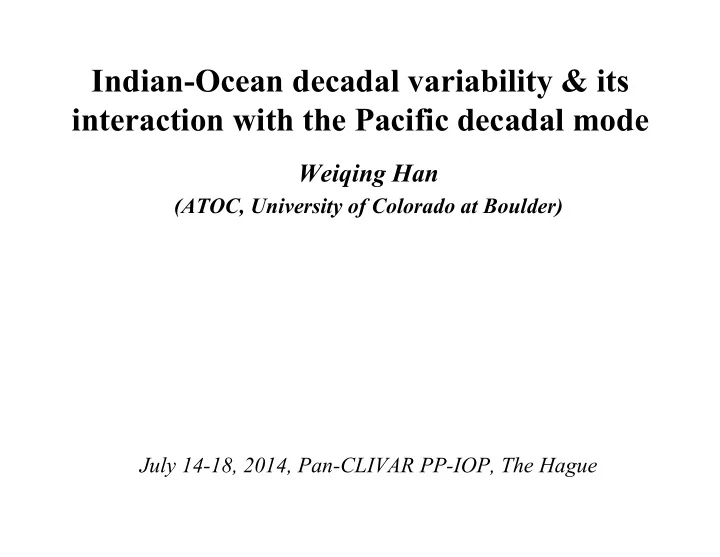

Indian-Ocean decadal variability & its interaction with the Pacific decadal mode Weiqing Han (ATOC, University of Colorado at Boulder) July 14-18, 2014, Pan-CLIVAR PP-IOP, The Hague
Background: a) Pacific Decadal Variability Mode Interdecadal Pacific Oscillation (IPO) (EOF1 of 8-yr lowpassed HadISST) IPO & PDO indices: Highly correlated with ENSO decadal Variability: R(ipo/mei)=0.89
b) Indian Ocean Warming trend & Decadal Variability 0-700m heat content over the Indian Ocean (IO) Multi-decadal warming trend: existing studies attributed primarily to anthropogenic greenhouse gas forcing; Overlying on the trend: decadal & multi-decadal variability
Indian Ocean Decadal SST EOF Modes Decadal Indian Ocean basin mode (DIOB) 8yr- Lowpassed, Detrended, Demeaned. (Review paper by: Han, Vialard, McPhaden, Lee, Masumoto, Feng, de Ruijter, 2014) Decadal variability of Indian Ocean Dipole (IOD) (Ashok et al. 2004; Song et al. 2007; Tozuka et al. 2007) 9-35yr
Goal of this talk: report some recent results on understanding Indian Ocean decadal variability, focusing particularly on its connection & interactions with the IPO. Specifically, we discuss (1) DIOB – IPO relation, and the active impact of DIOB on Pacific circulation; (2) Variability of Indian & Pacific Walker Cells associated with the IPO phase transition (preliminary results).
Results: (1) DIOB – IPO relation DIOB IPO Indices IPO may have important contributions to R=0.54 (1874-2006) the DIOB , similar to ENSO impact on IO R=0.75 (1900-1984) R=-0.85 (1984-2008) SST at interannual timescales. DIOB is not likely induced by IPO after mid-1980s; causes are not known and are under investigation; DIOB actively impacts the Pacific winds and sea level after mid-1980s .
DIOB + IPO cause WTP sea level intensification Linear trends (1993-2010) of satellite (AVISO) SSH Decadal thermosteric SLA 700m (Global mean SLR removed) (Ishii & Kimoto 2009) WTP ( 8yr lowpassed: detrend demean ) Recent studies: decadal sea level variability of the WTP is highly correlated with the indices of IPO/PDO & decadal variability of ENSO (e.g., Merrifield 2011, Merrifield et al. 2011, 2012; Zhang&Church 2012, Meyssignac et al. 2012)
Has the IPO intensified since 1990? No. Negative correlation; However, IPO hasn’t intensify, but SSHA has! 700m thermo. IPO alone can not explain the SSHA WTP sea level intensification
a)-b) Multidecadal timescales(>20yrs): Intensified WTP SLR since 1993 (d) c) (Han et al. 2013) 1. Satellite/in situ 700m thermo. SLA agree: upper-ocean variability dominates SSHA on ‘multi-decadal’ timescale; 2. Wind/SSHA Co-vary: wind-driven
Intensified SSHA & Intensified EQ winds Why do the winds intensify? Changing Indian Ocean (IO) SST/IPO relation since 1985!
SSH trend, 1993-2010 ORA-S3 windstress AVISO IPO (CSEOF) Hamlington et al. 2013, 2014 AVISO - IPO Hamlington et al. (2014), Nature Climate Change, Accepted.
AGCM wind stress & Ekman pumping velocity c) SST+wind trend for +IPO d) SST+wind trend for –IPO Han et al. 2013
SSH trend, 1993-2010, residual = (AVISO – IPO) Linear Ocean model, SSH trend 1993-2010 Hamlington et al. (2014)
Summary I ! The SST DIOB appears to be largely induced by the IPO before the mid-1980s; after the mid-1980s, however, the DIOB and IPO are out of phase; causes for this change remain unclear and are being investigated; ! The out of phase relation between DIOB & IPO after the mid-1980s causes intensified (decadal and) multidecadal sea level variability in the WTP.
(2) Variability of Indian & Pacific Walker Cells associated with the IPO phase transition (Han et al. 2014, work in progress) Linear trends: 1993-2000 2000-2006 SSH SSH Wind Curl Wind Curl Lee and McPhaden (2008): Strong Indo-Pacific teleconnection ; Decadal: ~14yr from 1993-2006 Nidheesh et al. (2013): 1966-2007, 7yr lowpassed fields: (decadal & longer) teleconnection is weak.
Trenary and Han (2013) Indian Ocean wind Dominates; Indo-Pacific connection primarily atmosphere, Walker Cell?
On decadal & multidecadal timescales, do the variations of Walker Cells over the Indian & Pacific Oceans co-vary? (surface winds – surface branch of the Walker Cell) IPO- IPO+ EOF1 of 8-yr lowpassed HadiSST & PC, IPO
Linear trends of surface windstress (arrows) corresponding to IPO multidecadal phase transition Tropical Indian & Pacific: Do NOT co-vary (Arrows >90% significance are shown)
Linear trends of MERRA wind stress (arrows) corresponding to IPO decadal phase transition Negative transition Positive transition Arrows with 90% significance plotted Tropical Indian & Pacific:Co-vary!
Decadal trends of CAM4 wind stress (arrows) corresponding to IPO phase transitions (arrows with >90% significance are plotted)
Summary II ! On decadal timescales, the surface branches of the Indian and Pacific Walker Cells (surface winds) co- vary, converging to/diverging from the Maritime continent; ! On multidecadal timescales, however, they do not co- vary; this incoherent change may have contributed to the weak Indian-Pacific correlation found in Nidheesh et al. (2013), which incudes both decadal & multidecadal variability; ! Challenge: short records for reliable, consistent datasets
Linear trends: Satellite SSHA & upper 700m thermo. SLA 1. Satellite/in situ 700m thermo. SLA agree: upper-ocean variability dominates SSHA on ‘decadal’ timescale; 2. Wind/SSHA Co-vary: wind-driven
Intensified WTP SLA (8yr lowpassed): Thermo. SL & ECMWF ORA winds
Fremantle tide gauge since 1897 (>100yr) (5yr lowpass) From Feng et al. (2010)
Observed/LOM simulated annual mean SSHA time series Decadal SSHA: Wind-driven!
Recommend
More recommend